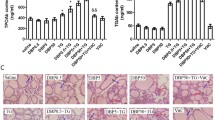Summary
Diabetes-prone biobreeding (BB) rats often develop lymphocytic thyroiditis. Intraperitoneal administration of silica to young BB rats (40-days-old) nearly completely prevented the development of lymphocytic thyroiditis as well as insulitis. Since silica is known to be toxic to macrophages, these data suggest that the presentation of autoantigen(s) on the specific target cells such as thyroid and pancreatic B cells by antigen-presenting cells (e.g., macrophages) would be the initial step in the development of organ-specific autoimmune diseases in diabetes-prone BB rats.
Similar content being viewed by others
References
Marliss EB, Nakhooda AF, Poussier P, Sima AAF (1982) The diabetic syndrome of the “BB” Wistar rat: possible relevance to Type 1 (insulin-dependent) diabetes in man. Diabetologia 22: 225–232
Sternthal E, Like AA, Sarantis K, Braverman LE (1981) Lymphocytic thyroiditis and diabetes in the BB/W rat: a new model of autoimmune endocrinopathy. Diabetes 30: 1058–1061
Lee KU, Kirn MK, Amano K, Pak CY, Jaworski MA, Mehta JG, Yoon JW (1988) Preferential infiltration of macrophages during the early stage of insulitis in the diabetes-prone BB rats. Diabetes (in press)
Kiesel U, Oschilewski M, Kantwerk G, Maruta M, Hanenber H, Treichel U, Kolb-Bachofen V, Hartung HP, Kolb H (1986) Essential role of macrophages in the development of Type 1 diabetes in BB rats. Transplant Proc 6: 1525–1527
O'Rourke EJ, Halstead SB, Allison AC, Platts-Mills TAE (1978) Specific lethality of silica for human peripheral blood mononuclear phagocytes, in vitro. J Immunol Methods 19: 137–151
Lee KU, Amano K, Yoon JW (1988) Evidence for the initial involvement of macrophage in the development of insulitis in nonobese diabetic (NOD) mice. Diabetes (in press)
Sokal RR, Rohlf FJ (1969) Biometry: the principles and practice of statistics in biological research. Freeman, San Francisco, pp 585–601
Unanue ER, Allen PM (1987) The basis for the immunoregulatory role of macrophages and other accessory cells. Science 236: 551–557
Murphy GF, Messadi D, Fontferko E, Hankock WW (1986) Phenotypic transformation of macrophages to Langerhans cells in the skin. Am J Pathol 123: 401–406
Toews GB, Bergstresser PR, Streilein JW (1980) Epidermal Langerhans cell density determines whether contact hypersensitivity or unresponsiveness follows skin painting with DNFB. J Immunol 124: 445–453
Author information
Authors and Affiliations
Rights and permissions
About this article
Cite this article
Lee, K.U., Pak, C.Y., Amano, K. et al. Prevention of lymphocytic thyroiditis and insulitis in diabetes-prone BB rats by the depletion of macrophages. Diabetologia 31, 400–402 (1988). https://doi.org/10.1007/BF02341511
Received:
Issue Date:
DOI: https://doi.org/10.1007/BF02341511




